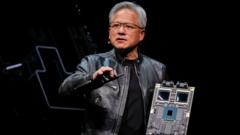The arrival of Moon dust in the UK marks a significant moment in lunar research and international space collaboration, with scientists preparing to unlock the mysteries of the Moon's formation.
Moon Dust Returns: China's Rare Lunar Samples Arrive in the UK

Moon Dust Returns: China's Rare Lunar Samples Arrive in the UK
The precious lunar samples from China's Chang'e 5 mission land in Milton Keynes, igniting fresh scientific inquiries into the Moon's origins.
The long-awaited lunar dust samples, collected by China's Chang'e 5 mission in 2020, have officially arrived in the UK, marking a pivotal moment for scientific exploration. Now safely stored in a high-security facility in Milton Keynes, the Moon dust is considered "rarer than gold" by Professor Mahesh Anand, the only UK scientist granted access to these samples.
Professor Anand, who traveled to Beijing to collect the materials, expressed immense gratitude for the opportunity, stating that having access to these once-in-a-lifetime samples is both an honor and a privilege. The Chinese mission was the first successful lunar soil collection since the 1976 Soviet effort, leading to questions about the Moon's formation and the early history of Earth.
The dust, collected from a volcanic site on the Moon, is expected to provide insight into the theory that the Moon originated from debris produced when Earth collided with a Mars-sized body around 4.5 billion years ago. With only 60 milligrams at their disposal, Professor Anand and his team are preparing for meticulous laboratory work, ensuring the samples remain uncontaminated.
In a clean lab environment, every precaution is taken to maintain the purity of the Moon dust, from sticky mats for shoe cleaning to protective gowns. The samples, though small and seemingly unremarkable at first glance, hold vast scientific potential. Technician Kay Knight will begin the work of preparing the dust, a task she has eagerly anticipated after decades of cutting other rock samples.
The team employs unique machinery capable of analyzing the components of the dust at extreme temperatures and with precision laser techniques. These tools, including one that can detect the gases trapped within the grains, are crucial to uncovering the secrets held by the Moon's surface material.
As they delve into this research, the team is acutely aware that their analysis may cause irreversible changes to the samples. With a timeframe of one year to carry out their work, there is a sense of urgency to extract as much knowledge as possible.
Looking ahead, Professor Anand hopes this collaboration with China heralds a new era of international cooperation in lunar exploration. He draws on the historical significance of the Apollo missions that shaped his career and calls for a continuation of this collaborative spirit among spacefaring nations.
With China's Chang'e initiatives paving the way for future lunar discoveries, including plans for another mission to the Moon's far side, the world eagerly awaits the revelations that will emerge from this rare cosmic endeavor.

















